Blocking the Pandemic
Regional Boundary Controls in Indonesia’s Far East
Indonesia, whose population of 267 million inhabits a vast archipelago, has not been spared the challenge of the SARS-CoV-2 pandemic. The difficulty of managing the disease has been compounded by limited public health and health care capacity, and high mobility of people and goods within the country and across its borders. A noteworthy feature of the response is that regional administrations have taken the lead in restricting transportation between regions. Such measures have been prominent in some of Indonesia’s so-called ‘outer islands’ where health care infrastructures are especially uneven, resulting in a politics of ‘outside-in’ claims to authority.
During the past 10 years the country’s health system has seen significant improvements while remaining underfunded and uneven. Structural adjustments and decentralization implemented after the economic crisis of 1997-98 set the stage for a proliferation of private providers and an increase in total spending, while unequal access to care persists for lower-income and more isolated populations (Mahendradhata et al. 2017). The SARS-CoV-2 outbreak has particularly affected residents in the most densely populated parts of Indonesia, as the government has struggled to procure sufficient testing equipment. Jakarta counts nearly half of Indonesia’s fatal cases, and the four most affected provinces are on the island of Java. Observing developments in the center, representatives of outer regions—whose pockets of dense population are separated by wide distances with low infrastructural connectivity—have anticipated the problem of inadequate health care. Papua province is a case in point, and representatives have acted to protect limited health care capacity by suspending inbound and outbound travel. Papua and neighboring Papua Barat together form the contested territory known as West Papua to supporters of its independence movement. The long-running conflict has left an imprint on the politics of pandemic response. Representatives of constituencies in Papua’s highlands, where inadequacy of health care facilities is acute, have become visible participants in Indonesia-wide debates about relations between central and regional authority as it pertains to mobility and transportation.
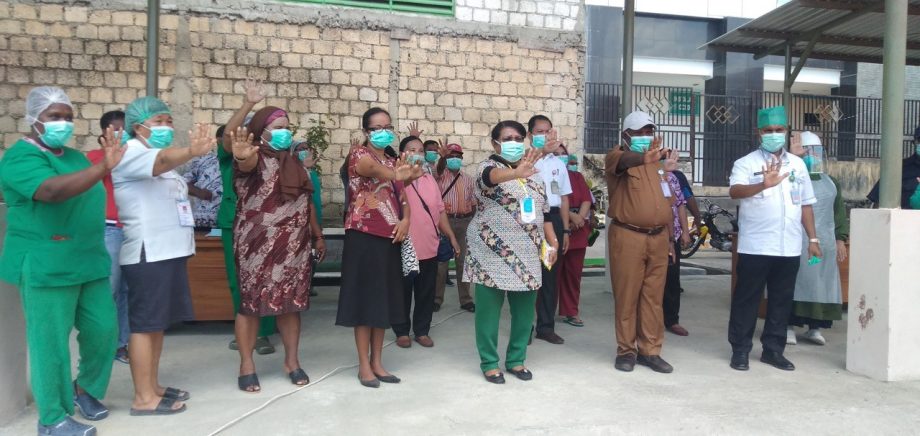
Head of provincial health agency along with management and staff of Abepura Public Hospital in Jayapura, Papua on 19 May 2020. © 2020 Jubi / Hengky Yeimo
Uneven Connections: Vulnerability and Leverage
While Papua’s vast interior remains weakly connected to major infrastructures, its handful of coastal cities are linked by human and commercial connections to the rest of Indonesia and the wider world. Papua’s coastal capital Jayapura is an entry point for newcomers from economically stagnant regions of Indonesia and a site of settlement for indigenous migrants from the highlands in particular. Jayapura’s port is habitually busy importing manufactured goods. Meanwhile the province exports a large quantity of natural resources such as timber and minerals; Mimika regency in Papua’s western highland area hosts the world’s largest gold mine, run by US-based Freeport McMoRan. The higher echelons of management and engineering at the mine consist mainly of internationally mobile professionals. Given these trans-regional and international connections it is not surprising that Jayapura and especially Mimika are the province’s top ‘red zones’ for SARS-CoV-2 in Papua province (The Jakarta Post 2020; “COVID-19 Provinsi Papua” 2020).
Far fewer cases have been reported for Papua’s major center of indigenous population, the La Pago territory of the central highlands. La Pago is home to a population of nearly one million, mostly smallholder sweet potato cultivators in rural areas, with road links to commercial and administrative hubs that are, for the most part, only accessible from the coast by air. Beyond its main town of Wamena and other administrative centers, the population mostly lives without modern water and sanitation infrastructures. Since 2010, I have conducted research on livelihoods and development in Wamena’s hinterland. The area has a reputation as a heartland of the independence movement: an armed guerrilla organization has operated in isolated areas, and an urban protest movement has sporadically mobilized in Wamena since the 1990s. After the crisis of 1997-98, protests and confrontations with security forces there were part of a Papua-wide movement that set the stage for negotiations that yielded reforms called Special Autonomy (Mote and Rutherford 2001; Sumule 2003). Autonomy provided for increased indigenous participation in government, regional authority in development planning, and expanded distribution programs.
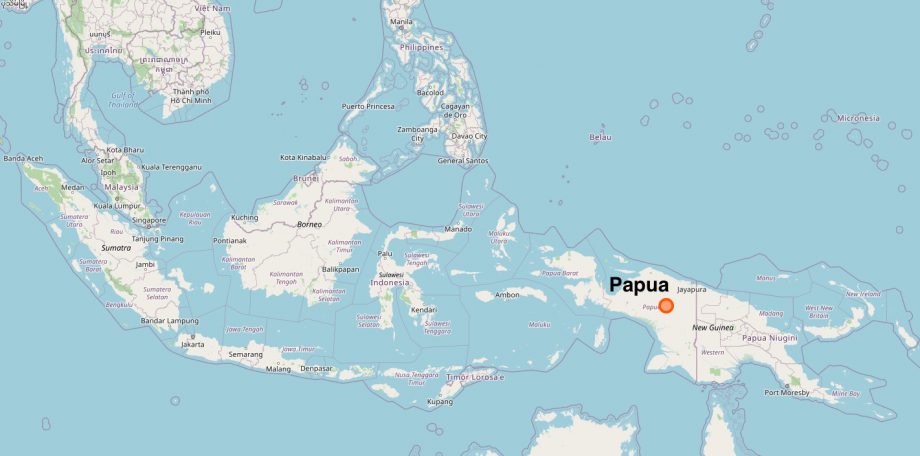
Map of Indonesia showing location of Papua, with Wamena marked in red. © OpenStreetMap contributors
While Autonomy in Papua aimed specifically to resolve the conflict there, it took shape alongside a wider post-crisis state decentralization promoted by the IMF and advised by the World Bank. These reforms saw discourses of ‘good governance’ applied to various agendas including defusing separatism; partial transfer of social protection functions and extractive revenues from the center to regions; and facilitation of construction and resource extraction firms’ direct access to regional administrations (Aragon 2007; Habibi and Juliawan 2018; Sangadji 2017; Silver 2003). In Papua, the Autonomy era has seen sporadic turbulence, as independence agitations and repression wax and wane. In particular, serious incidents of violence took place in many cities including Wamena in August and September 2019. Since the onset of the pandemic in Papua, local representatives and groups in La Pago have taken the lead and actively restricted inbound transportation (Gokkon 2020). These actions have had an assertiveness that has agitated relations between the center and regions in general.
Alongside the announcement of Indonesia’s first confirmed case on 2 March, and first death 11 March, a discourse alleging inadequate central government preparedness developed in domestic and international media (McBeth 2020). The week starting 23 March saw a flurry of announcements and statements on the question of restricting mobility between regions. An early decision was announced by John Banua, bupati (regent) of Jayawijaya regency in the central part of La Pago, who on 23 March stated that Wamena airport would be closed to passenger travel starting later that week (Yewun 2020). The announcement took up popular demands for government leaders to restrain the movement of people into Papua—at a time when the virus was just beginning to be detected there. While other regencies made similar announcements regarding their airports, the governor of Papua province Lukas Enembe declared that all passenger travel into Papua would be suspended as well (Mawel and Mambor 2020). Papua Barat’s governor soon followed suit, and neighboring Maluku instituted its own travel ban.
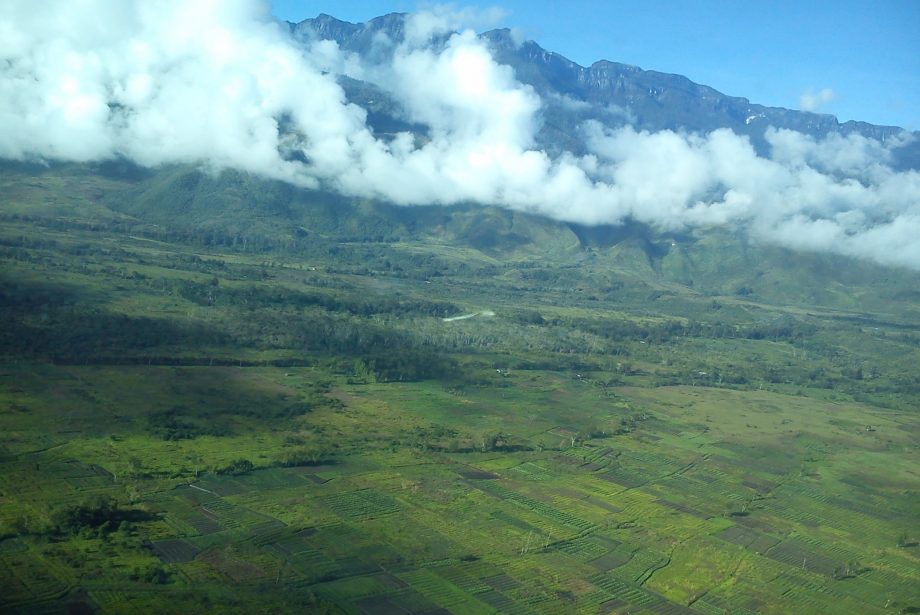
Agrarian landscape in Jayawijaya, Papua, Indonesia. © 2020 Jacob Nerenberg
The proliferation of regional-led travel bans has been characteristic of provinces such as Papua with low health care capacity and high rates of in-migration and travel in and out. The rationale was put in stark terms by Dr. Silwanus Sumule, spokesperson of Papua’s COVID-19 Task Force, who on 26 March while commenting the presence of seven positive cases in Papua, made a stark statement in which he addressed anyone in the audience with plans to travel to Papua:
“Why did we disallow outsiders from coming here? Because if you come to Papua, you will die. I’m sorry for this overly direct language. Why? Just to handle our own population, our hospitals are not capable—and what’s more, if others come here! We have already said it again and again; we are not capable. So the best thing is, don’t come to Papua as long as this is ongoing. If you come here, and if you are infected with COVID-19, I can guarantee that we are not capable of treating you.” (Jangan Datang Ke Papua 2020; Smart City Makassar 2020)
In previous interviews, Dr. Sumule had explained his concern that the pandemic could overwhelm Papua’s health system, with just seven lung specialists and 62 ventilators for all of the province’s 3.4 million people (Flassy 2020). The video of Dr. Sumule’s statement circulated widely on social media, attracting support as a compelling statement of the fragile health situation and the relevance of suspending travel links. However, the legitimacy of Papua’s travel shutdowns was questioned at the center, as two top government ministers denied that regions have the right to unilaterally suspend travel in and out of their territories (Nugraheny 2020). Such denials were met with firm responses from Papua, notably from Ham Pagawak, head of one of La Pago’s smaller regencies (Warta Kota 2020). Meanwhile, regions far from Papua implemented their own restrictions. The town of Tegal, east of Jakarta on Java’s north coast, announced it was shutting roads in and out for a period of four months. The governor of Jakarta, Anies Baswedan, seized on the discourse and accused the central government of narrowing his authority to handle the pandemic (Straits Times 2020).
While media controversy swirled over the status of regional travel suspensions, the central government introduced a mechanism for regions to request authorization for regional quarantines. This framework covers restrictions on mobility within regions, and there remains uncertainty over the legitimacy of unilateral suspensions of inbound and outbound travel by regional administrations. The responses and debates took place in the lead-up to the start of Ramadan—a time when some of Jakarta’s population visits hometowns (a practice known as mudik) to open the fast with relatives. Under pressure to take action, president Joko Widodo announced on 24 April a last-minute interdiction on mudik for the duration of Ramadan. The ban covers Eid ul Fitri (also known as Lebaran in Indonesia), which in normal years leaves Jakarta virtually deserted, and also sees significant departures from Papua by newcomer residents.
For the La Pago area, which has long lacked a paved road to the coast, shutting the airport to passenger travel was a simple way to have an immediate impact. The Jayawijaya administration has continued to permit cargo flights to land with essential goods—a vital channel given the need for medical items as well as food products such as rice. Recent progress in construction of the long-anticipated road linking Jayapura to Wamena (passing through steep mountain ranges and vast forests and swamps) has complicated travel restrictions. Responding to reports that vehicles had passed through recently cleared but unfinished sections of road into the highlands, officials in Yalimo regency led a team of volunteers to set up and monitor a checkpoint (Lokobal 2020). Such local government initiatives have also been reported in other areas of Papua, notably between the coastal town of Nabire and the boundary with Papua Barat province.
Shortly after regional travel restrictions were implemented, the Papua conflict returned to the news. On 30 March, an attack attributed to the West Papua Liberation Army killed a Freeport miner from New Zealand, and military pursuit of those responsible resulted in further casualties (Bayer 2020). Meanwhile in Jakarta, six pro-independence protesters were facing trial. Reappearance of violence has heightened controversy over the legitimacy of regional administrations’ boundary enforcements. It remains to be seen whether and how the central government may incorporate such regional initiatives into its mechanisms for responding to public health emergencies.
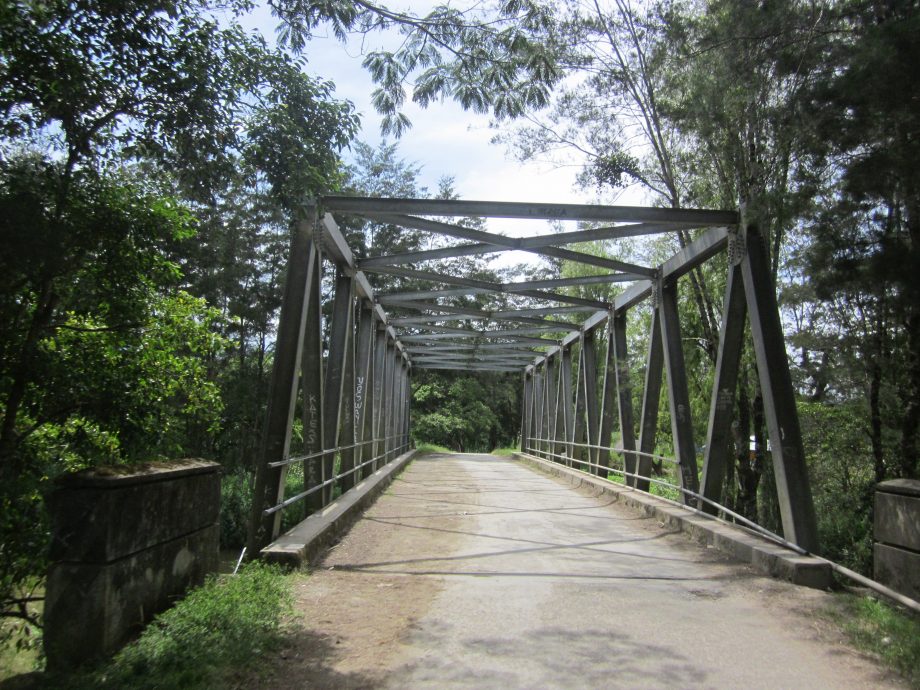
Road and bridge in Jayawijaya, Papua, Indonesia. © 2020 Jacob Nerenberg
The partial, temporarily heightened, and contested legitimacy of regional-level control resonates with debates regarding measures to prevent disease spread to outlying regions and indigenous populations elsewhere in the world. In North America, examples include protests by Haida residents against visits from the British Columbia mainland; police checkpoints stopping non-essential travel into parts of Québec, especially in the north; and a lawsuit by the governor of South Dakota against two Lakota nations for implementing checkpoints (Kelly 2020; ICI.Radio-Canada.ca 2020; Walker 2020). Meanwhile in Brazil, indigenous groups in Amazonian borderlands have demanded the central government enforce a court decision prohibiting entry of US missionaries into their territory (Telesurtv.net 2020). Inadequate health facilities, tensions between policies of isolation or connection toward indigenous populations, sovereignty claims of various kinds, and policies to suppress or anticipate them—these factors have been involved in enactments of boundary controls normally associated with central governments. The post-crisis history of decentralization in Indonesia, with its conflict-resolution rationale in Papua, set the stage for such assertions to affect national-scale pandemic politics—while harm from the disease remains concentrated among workers at the country’s center.
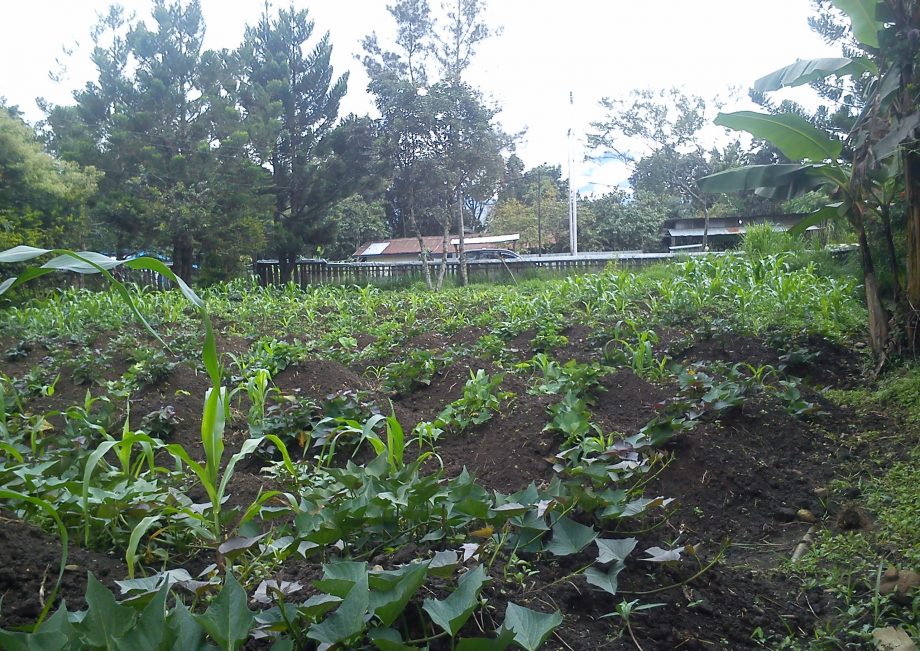 Sweet potato garden on outskirts of Wamena, Papua, Indonesia. © 2020 Jacob Nerenberg
Sweet potato garden on outskirts of Wamena, Papua, Indonesia. © 2020 Jacob Nerenberg
Compared to residents of Indonesia’s cities, the capacity to cultivate their own food makes indigenous smallholders in La Pago in some ways better equipped to withstand the pandemic’s interruption of regular economic life. Claims to authority over inbound travel by public representatives in Papua signal a combination of vulnerability due to inadequate health infrastructures, and partial leverage over transportation due to the region’s relative disconnection. The pandemic has allowed this contradictory combination to complicate Indonesia’s inter-governmental politics in the long wake of decentralization.
Written on 29 April 2020, revised on 21 May 2020
Jacob Nerenberg is a Research Fellow at Leibniz-Zentrum Moderner Orient (ZMO) with the research group on Environment and Justice. He completed his PhD in Anthropology at University of Toronto in 2018, and was a postdoctoral fellow in the Department of Anthropology at York University. He conducts research on agrarian livelihoods, pluralism, and valuations of land in a context influenced by transnational extractive economy in the Papua region of eastern Indonesia. Email: jacob.nerenberg(at)zmo.de
#Witnessing Corona
This article was simultaneously published on the Blog Medical Anthropology . Witnessing Corona is a joint blog series by the Blog Medical Anthropology / Medizinethnologie, Curare: Journal of Medical Anthropology, the Global South Studies Center Cologne, and boasblogs.
References
Aragon, Lorraine V. 2007. “Elite Competition in Central Sulawesi.” In Renegotiating Boundaries: Local Politics in Post-Soeharto Indonesia, edited by Henk Schulte Nordholt and Gerry Van Klinken. Leiden: KITLV Press.
Bayer, Kurt. 2020. “Gold Mine Attack: New Zealand Man Graeme Wall Reportedly Shot and Killed by Rebels.” NZ Herald, March 30, 2020. https://www.nzherald.co.nz/nz/news/article.cfm?c_id=1&objectid=12321121. Last access: 28/04/2020.
Kelly, Alanna. 2020. “Haida Gwaii Residents Protest Arrival of BC Ferries amid
COVID-19.” April 29, 2020. https://vancouverisland.ctvnews.ca/we-are-scared-haida-gwaii-residents-protest-arrival-of-bc-ferries-amid-covid-19-1.4916972. Last access: 15/05/2020.
“COVID-19 Provinsi Papua.” 2020. https://covid19.papua.go.id/. Last access: 19/05/2020.
Flassy, Angela. 2020. “Warga Dari Luar Papua Diminta Tunda Kunjungan Ke Papua.” JUBI (blog). March 23, 2020. https://tabloidjubi.com/warga-dari-luar-papua-diminta-tunda-kunjungan-ke-papua/. Last access: 21/04/2020.
Gokkon, Basten. 2020. “Indigenous Papuans Initiate Own Lockdowns in Face of COVID-19.” Mongabay Environmental News. April 6, 2020. https://news.mongabay.com/2020/04/indigenous-papuans-initiate-own-lockdowns-in-face-of-covid-19/.Last access: 12/05/2020.
Habibi, Muhtar, and Benny Hari Juliawan. 2018. “Creating Surplus Labour: Neo-Liberal Transformations and the Development of Relative Surplus Population in Indonesia.” Journal of Contemporary Asia 48 (4): 649–70. https://doi.org/10.1080/00472336.2018.1429007.
ICI.Radio-Canada.ca, Zone Santé-. 2020. “Les chefs innus satisfaits du maintien des contrôles routiers sur la Côte-Nord | Coronavirus.” Radio-Canada.ca. Radio-Canada.ca. May 14, 2020. https://ici.radio-canada.ca/nouvelle/1703125/frontieres-fermees-cote-nord-tadoussac-autochtones-sante-publique-covid-19. Last access: 12/05/2020.
Jangan Datang Ke Papua. 2020. Jayapura: Suara Papua Official. https://www.youtube.com/watch?v=nLa942HFFB8. Last access: 17/05/2020.
Lokobal, Onoy. 2020. “Memutus Penyebaran Covid-19 ke Laapago, Jalan Darat Keerom – Yalimo Ditutup.” Suara Papua (blog). Last access: April 20, 2020. https://suarapapua.com/2020/04/20/memutus-penyebaran-covid-19-ke-laapago-jalan-darat-keerom-yalimo-ditutup/. Last access: 26/04/2020.
Mahendradhata, Yodi, Prastuti Soewondo, Tiara Marthias, Pandu Harimurti, John Prawira, Shita Listyadewi, and Laksono Trisnantoro. 2017. The Republic of Indonesia Health System Review. WHO Regional Office for South-East Asia. https://apps.who.int/iris/handle/10665/254716.
Mawel, Benny, and Victor Mambor. 2020. “Papua Restricts Entry as Concerns Mount over Lack of Facilities to Treat COVID-19.” The Jakarta Post. March 25, 2020. https://www.thejakartapost.com/news/2020/03/25/papua-restricts-entry-as-concerns-mount-over-lack-of-facilities-to-treat-covid-19.html. Last access: 24/04/2020.
McBeth, John. 2020. “Why Indonesia Has World’s Highest Covid-19 Death Rate.” Asia Times, March 20, 2020. https://asiatimes.com/2020/03/why-indonesia-has-worlds-highest-covid-19-death-rate/. Last access: 30/04/2020.
Mote, Octovianus, and Danilyn Rutherford. 2001. “From Irian Jaya to Papua: The Limits of Primordialism in Indonesia’s Troubled East.” Indonesia, no. 72: 115–40. https://doi.org/10.2307/3351483.
Nugraheny, Dian E. 2020. “Mendagri Tak Setuju Pemprov Papua Tutup Wilayah akibat Covid-19.” KOMPAS.com, March 25, 2020. https://nasional.kompas.com/read/2020/03/25/07591621/mendagri-tak-setuju-pemprov-papua-tutup-wilayah-akibat-covid-19. Last access: 02/05/2020.
Sangadji, Arianto. 2017. “20 Years after Reformasi: Capitalist Development and Anti-Capitalist Movement in Indonesia.” Presented at the Centre for Southeast Asian Studies, University of Toronto, October 6.
Silver, Christopher. 2003. “Do the Donors Have It Right? Decentralization and Changing Local Governance in Indonesia.” The Annals of Regional Science 37 (3): 421–34. https://doi.org/10.1007/s00168-003-0162-9.
Smart City Makassar. 2020. “Tujuh Orang Positif Corona Di Papua,” March 27, 2020. https://smartcitymakassar.com/2020/03/27/tujuh-orang-positif-corona-di-papua/. Last access: 23/04/2020.
Straits Times. 2020. “Jakarta Governor Anies Baswedan Slams Red Tape in Coronavirus Pandemic Fight,” April 6, 2020. https://www.straitstimes.com/asia/se-asia/jakarta-governor-anies-baswedan-slams-red-tape-in-pandemic-fight. Last access: 23/04/2020.
Sumule, Agus. 2003. “Swimming Against the Current: The Drafting of the Special Autonomy Bill for the Province of Papua and Its Passage through the National Parliament of Indonesia.” The Journal of Pacific History 38 (3): 353–69.
Telesurtv.net. 2020. “Indígenas denuncian gestión de Gobierno brasileño ante Covid-19,” April 17, 2020. https://www.telesurtv.net/news/univaja-indigenas-brasil-coronavirus-20200417-0007.html. 26/04/2020. Last access: 20/05/2020.
The Jakarta Post. 2020. “Mimika Regent Urges Jokowi to Close Freeport Mine after Workers Test Positive for COVID-19,” May 10, 2020. https://www.thejakartapost.com/news/2020/05/10/mimika-regent-urges-jokowi-to-close-freeport-mine-after-workers-test-positive-for-covid-19.html. Last access: 17/05/2020.
Walker, Dalton. 2020. “South Dakota Tribes Stand Firm behind Checkpoints.” IndianCountryToday.Com, May 12, 2020. https://indiancountrytoday.com/news/south-dakota-tribes-stand-firm-behind-checkpoints-yKqqBIxRGkCXueAjMKH7oA. Last access: 20/05/2020.
Warta Kota. 2020. “Luhut Panjaitan Larang Pemda Lockdown, Bupati Mamteng: Jangan Bicara Sembarangan, Ini Rakyat Kami,” April 1, 2020. https://wartakota.tribunnews.com/2020/04/01/luhut-panjaitan-larang-pemda-lockdown-bupati-mamteng-jangan-bicara-sembarangan-ini-rakyat-kami. Last access: 23/04/2020.
Yewun, Marius Frisson. 2020. “Pemkab Jayawijaya Tutup Akses Penerbangan Penumpang Di Bandara Wamena.” Antara News Papua, March 23, 2020, sec. Indonesia. https://papua.antaranews.com/berita/534582/pemkab-jayawijaya-tutup-akses-penerbangan-penumpang-di-bandara-wamena. Last access: 22/04/2020.































